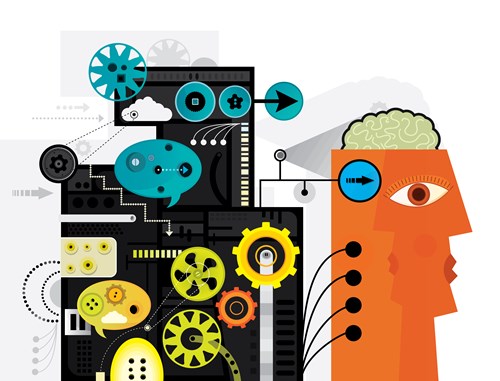At the core of the investment themes that we are finding most exciting today is digitisation. Autonomous driving, additive or 3D manufacturing, generative design, and the smart factories of Industry 4.0… Creative destruction is in full force. What is important is the immediacy of the new and the scale of change.
Since the beginning of the Industrial Revolution in the late 1700s, most of us who lived in the Western world must have believed that our times were the most significant in terms of scientific discoveries and technological progress. Never has it been truer than today when inventions first conceived of 10 or 20 years ago are now converging to produce extraordinary, yet commonplace, products and services that we consume and experience in our daily lives. (This zeitgeist is also now a truly global one, with countries like Japan and China racing the West in many fields.) Autonomous driving, additive or 3D manufacturing, generative design, and the smart factories of Industry 4.0… The notion of creative destruction, described by Joseph Schumpeter as the process of industrial mutation that incessantly revolutionises the economic structure from within, rings loudly in this digital age.
Innovation and the rate of change are obviously important from an investment perspective. New companies will emerge, offering spectacular returns, and in many instances it will be at the cost of other companies who will struggle to stay relevant. We have all lived through the commercialisation of the Internet which culminated in the dot com bubble but set in motion entirely new industries and businesses such as e-commerce, enterprise software and social media, and that revolution was followed by another with the proliferation of smart phones and mobile connectivity. Companies such as Microsoft, Google and Facebook as well as Tencent and Alibaba in Asia have provided alert investors with magnificent returns. But, what’s next?
At the core of the investment themes that we at Platinum are finding most exciting today is digitisation, and an aspect worth emphasising is the immediacy of many of these emerging opportunities. Some of the developments referred to below are already in the mainstream or will be within two to three years, which accord with the approximate time horizon of stock markets.
AI and Autonomous Driving
Consider artificial intelligence (AI). Some of the neural network algorithms stealing headlines today were formulated in as early as the 1960s, but lay dormant until the present decade when they were brought to life by the availability of big data and the use of graphic processing units (GPUs). GPUs are a specialised type of microchips originally designed for video games, but have proven to be well-suited to machine learning, enabling computers to see, converse, navigate, and create. The application of these AI capabilities is in turn accelerating multitudes of other developments.
Most notable is how far autonomous driving technology has come since it came into the public’s purview just a few years ago. During Waymo’s (a Google spin-off) test drives in California throughout 2017, its self-driving vehicles on average travelled nearly 6,000 miles without needing a human driver to take over.1 Autonomous driving isn’t some distant moon-shot experiment. It is real and is here now. Level 3 self-driving cars, where a back-up human driver is required but can be completely hands-off, is already available on the Audi A8. Level 4 automation, where the driver can snooze for the entire trip and no human back-up is needed, is predicted by car makers like Ford, Daimler, Volvo and BMW for commercial launch in three years’ time.
In the meantime, General Motors (GM) is racking up testing miles and assembling comprehensive mapping data of cities like San Francisco, Phoenix and soon, Manhattan, while offering ride-sharing services with its self-driving Cruise. By removing the human driver, GM estimates that the cost of a ride can be reduced from US$2.00–3.00 per mile to a target cost of US$1 or lower!2 This dramatic cost reduction could result in a massive new ride-share market.
None of these developments could have been achieved without ever more powerful chips, lower cost sensors and cameras, and faster transmission of data. Leading GPU-maker Nvidia has been aggressively expanding its offerings of specialised processors that act as the brains of autonomous vehicles, including a recently announced system-on-a-chip (SOC) that further lifts both processing power and energy efficiency. Meanwhile Mobileye – now part of Intel – is advancing its fifth generation SOC, which runs its proprietary image processing algorithms and is aiming for volume production by 2020. The company is also seeking to create a third-party crowd-sourced mapping service where all vehicles equipped with Mobileye’s technology will be gather and transmit road condition data to the cloud in real time for the server to aggregate and reconcile into an accurate and up-to-date “roadbook”, which is then made available to all vehicles on its network. Needless to say, auxiliary products such as sensors, cameras and LiDARs generate their own momentum as they attempt to serve the new opportunities arising from autonomous driving.
Digitisation of Manufacturing
Digitisation isn’t just happening on our smart phones and smart cars and homes; it is happening deep inside our industrial processes. It’s not only products that are being digitised; but also how they are developed and manufactured.
Industry 4.0 – the idea of revolutionising manufacturing through automation, data exchange, AI, and the Internet of Things (IoT) – is being pursued vigorously by German industrial companies led by Siemens. Their product lifecycle management (PLM) system operates with “digital twins” – virtual replicas that accurately simulate each aspect of the physical product and seamlessly interlink every stage of the production process, from product inception to testing and improvement, to plant configuration and stock replenishment. Siemens is presently operating two digital twin factories, one in Germany and another in China. Any change made along any part of the “digital thread” of a product’s lifecycle is instantaneously transmitted to the other factory 8,000 km away. The company wants to use its digitisation platforms to transform manufacturing processes into “cyber-physical systems” in which digitised machines and work-pieces directly communicate with each other via ubiquitous wireless connectivity and, ultimately, make autonomous decisions about the next production step.
Generative Design and Additive Manufacturing
Digitisation is also embodied in the convergence of generative design, additive or 3D manufacturing and new materials. Companies such as Autodesk has taken computer-aided design (CAD) tools to a whole new level, employing AI-driven software to create new designs that are mathematically optimised for the desired attributes, whether it is durability, efficiency, low-cost or environmental sustainability, after exploring and evaluating thousands of alternatives in simulation.
Combined with 3D printing techniques and new alloys, polymers and other innovative materials, the results are often remarkably different from the designs conceived for classical manufacturing methods. Geometries that were once only possible in 2D drawings can now be rendered in 3D slice by slice, layer by layer, using laser sintering, providing unprecedented versatility.
Importantly, 3D printing is no longer confined to the domain of prototyping or hobbyists. Companies like General Electric (GE) and Siemens as well as a host of start-ups have been active in developing additive manufacturing for use at industrial scales. GE is using the technology to produce jet engine parts that are lighter and significantly more fuel-efficient, while others are 3D-printing fully functional bridges and houses.
Cryptocurrencies and Blockchains
The digitisation of the exchange of value has gone beyond electronic payment systems, and a new breed of asset known as “cryptocurrencies” has been the source of a recent great mania reminiscent of the Tulip: Bitcoin, Litecoin, Ether, Ripple… the list goes on. While the speculative fever for these digital tokens will inevitably subside, the underlying blockchain technology remains sound. By recording the entire transaction history over a network, a blockchain or similar distributed ledger protocols can disintermediate transactions and remove the need for centralised validation. This has promising real-world applications: speedy and low-cost money transfers, property registries, indeed, any kind of ownership record, which pose serious potential challenges to traditional institutions that profit by being the privileged, rent-seeking intermediary, such as banks and clearing houses. With its core features of decentralisation and traceability, it is possible that the blockchain technology is ushering us into a new paradigm of the Internet of Value, where there is no border or friction to the flow and exchange of assets.
Quantum and Beyond
These are just some of the themes we have been preoccupied with when building our portfolios. There are many more. Biotech is taking giant leaps with genetic therapy and data-enabled precision medicine, while the digitisation of personalised care, disease prevention and care management is forcing insurance companies and care providers to develop new business models.
Quantum computers are also on the horizon. These delicate machines that need to be kept in near absolute zero temperatures seek to harness the peculiar properties of sub-atomic particles into a means of performing superfast and super-complex calculations, cracking encryptions and solving in an instant optimisation problems that take classical computers years to process. Intel recently announced a 49-qubit quantum chip, and IBM has made its 20-qubit system available on its cloud platform. Others, including Australia’s own research institutions, such as the UNSW Centre for Quantum Computation, are in hot pursuit.
What seems magical can feel distant. The reality is that these technologies are very much already here. Funding for all these innovations is aided by cheap capital. Most important is the immediacy of the new and the scale of change.
We will be managing your money with this creative destruction in mind.
DISCLAIMER: The above information is commentary only (i.e. our general thoughts). It is not intended to be, nor should it be construed as, investment advice. To the extent permitted by law, no liability is accepted for any loss or damage as a result of any reliance on this information. Before making any investment decision you need to consider (with your financial adviser) your particular investment needs, objectives and circumstances. The above material may not be reproduced, in whole or in part, without the prior written consent of Platinum Investment Management Limited.



